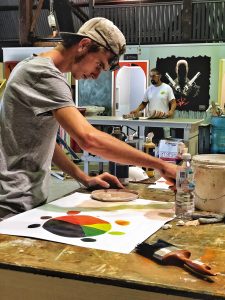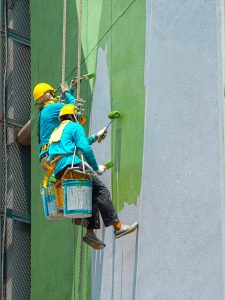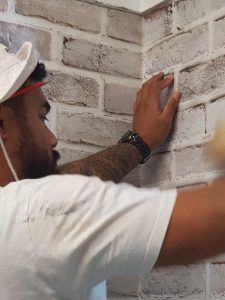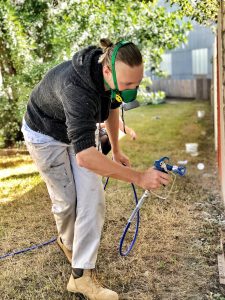





Painters and decorators are professional tradesman who apply paint, varnish, wallpaper and other finishes and special coatings to the walls, ceilings and other surfaces of residential, commercial, and industrial buildings and structures. The work of a painter and decorator has both a practical and a decorative function, since painting surfaces not only protects them from weather damage, erosion, mould and rust, but also makes them look more attractive.
How to Become a Painter and Decorator
Although there are no specific educational requirements to work as a painter and decorator, an apprenticeship in painting and decorating will provide students with a grounding in the key concept of the profession. Topics typically covered on courses include the main types of paints and varnishes, methods for estimating paint quantities, drying times, the use of colour swatches, analysing interior and exterior substrates and preparing them for painting, plastering and paint application techniques.
In addition to the theory, painters and decorators also need to acquire a wide range of practical skills, such as how to use brushes, rollers, filling blades, knives and other painting tools and how to apply the various types of paints and varnishes.
These skills are best learned through hands-on experience, under the watchful eye of a qualified supervisor (e.g. during an apprenticeship).
Aspiring painters and decorators require the following skills:
Painter Decorator – Career Path
The career of a painter and decorator typically begins with an apprenticeship under the supervision of a senior painting and decorating professional.
Subsequently, as they gain experience and expertise, they may work without supervision and eventually themselves supervise and assist young apprentices.
In more structured companies, such as construction firms with a large workforce, a painter and decorator may advance to a coordinating or leadership role, such as team leader or foreman.
Painters and decorators also have the option of setting up their own painting and decorating business and offering their services in a self-employed capacity.
One of the most common specialization options in the painting and decorating trade is to become a specialist decorator – a highly skilled worker with the ability to produce decorative artwork, murals and finishes (e.g. polished plaster, trompe l’oeil, faux marble and faux wood) and create decorative architectural elements (e.g. floral motifs, mouldings, friezes and architraves) for shops, restaurants, bars and homes.
Painters and decorators may also use their knowledge and experience to work as a salesperson in a painting and decorating shop, paint stockist, or another company operating in the paint and varnish industry.
The first task of a painter is to evaluate the size and condition of the surfaces to be painted and identify any preliminary work that may need to be carried out. On this basis, the painter and decorator then composes an estimate of the time and cost that will be necessary to complete the painting job, including labour and materials.
The next step is to prepare the work area and install or erect any scaffold towers, work platforms or stepladders that may be needed. Before starting painting work, any areas that do not require painting must be protected. For example, when painting a house, furniture, floors, skirting boards, doors and windows, plug sockets and light switches must be covered, while paintings, clocks and other items on shelves or hanging on walls should be removed.
The painter and decorator’s next task is to prepare the surfaces to be painted so that they are smooth, even and clean. This means removing old paint, varnish or wallpaper using tools such as scrapers and filling knives and levelling surfaces by filling in cracks and holes using plaster, putty or some other filler or sealant. When painting external walls and surfaces, a painter and decorator’s first task is to assess the condition of the areas to be painted. Any area of damaged or deteriorated plaster is then removed and repaired, while holes or cracks should be filled in. If necessary, a new layer of plaster may be applied to serve as a base layer for paint application. The area should also be clean and free of dust.
Once the surfaces to be painted have been made smooth and even, the actual painting work can begin. The painter and decorator chooses the most suitable type of paint based on the type of room (e.g. bathroom, kitchen, house, office, school etc.) or outside surface to be painted (e.g. eaves, walls, doors and windows, balcony or gate). The aim should be to select the product that will give the best possible results in the agreed colour. Where necessary, this process may involve preparing paint by mixing together different colours. Once the paint is ready, a base coat or primer is applied. This is used to cover the previous paint job and provide an even surface upon which to apply more coats of the new colour.
Once painting has been completed, the painter and decorator removes or dismantles any supporting structures (scaffold towers, work platforms and step ladders etc.), remove the protective covers or sheets, puts back any paintings, furniture and other items and cleans the work area and work tools.
In some cases, a painting and decorating job may involve additional finishing work. For example, a painter and decorator may be asked to produce an artistic design, pattern or effect on a wall, e.g. using a sponge technique, a finish such as polished plaster or faux marble, or one of the many other popular styles of decoration.
Painters and decorators also apply paint, varnishes and other coatings to metal and wooden surfaces, such as railings, doors and fences.
Painters and decorators work on a variety of interior and exterior surfaces, including walls, ceilings, facades, fences, railings, and gates of a wide range of buildings (e.g. houses and apartments, schools, public offices, shops, commercial buildings, bridges and other infrastructure, factories and industrial facilities). While most of their work consists of painting on timber, brick and plaster, painters and decorators can also work on materials such as iron, steel, concrete, plasterboard and many others substrates.
Painters and decorators utilise a broad variety of products, including water-based, solvent-based, breathable, washable, anti-mould, insulative and waterproofing paints, anti-rust coatings, varnishes and stains, enamels and resins. The tools they use to apply them include brushes, rollers and sprayers. When performing their work, painter and decorators wear painting overalls and gloves, as well as protective personal equipment to enable them to work safely.
Painters and decorators work for a range of different employers, including building companies, remodelling and restoration companies and paints and varnish factories.
Some have their own business and work in a self-employed capacity. Self-employed painter and decorators ideally have their own means of transport which they use to transport materials and reach work locations.
Painter and decorators typically have flexible working hours that can vary based on the painting and decorating jobs they have been contracted to do and the requirements of their clients (e.g. private individuals, architects, housing associations, local authorities, construction firms, building designers etc.).
Responsibilities and Tasks
The main tasks of a painter and decorator include:
Top Reasons to Work as a Painter and Decorator
Although painting and decorating is a manual trade, it still has its artistic and creative aspects. And while access to the profession may be easy, working as a professional painter and decorator takes considerable skill and technical ability – especially for those who specialize in producing artistic decorations.
The painting and decorating trade encompasses a wide range of different markets (including new builds, renovations and remodels, interiors and exteriors) and materials (e.g. paints, varnishes, stains, enamels, resins, wallpaper etc.), all of which adds up to a dynamic and stimulating atmosphere.
Finally, another key attraction is the sense of personal and professional satisfaction that comes from being able to stand back and see the tangible results of one’s hard work.